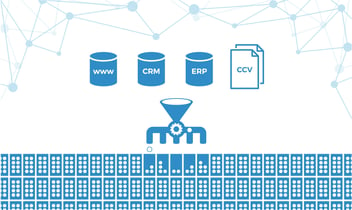Data consolidation is a vital step towards integration and data management.
Today, many companies are looking for ways to increase their competitiveness, their efficiency and effectiveness and their adaptability to unexpected changes. Those that are able to visualize data from all their departments in a comprehensive way are better prepared than others to make predictions, detect errors and make decisions based on valuable information extracted from their big data.
However, many times the big data that companies store is made up of data from diverse origins, with various formats and with different purposes. This can result in duplication, paying for multiple licenses for different software, or problems with data security.
In addition, this great diversity makes it difficult to quickly and efficiently analyze the data, so it must be treated to make it more uniform, eliminate errors and duplicates, and for it to be in the right place, such as a data warehouse or data lake. This process is known as integration and can be carried out using various methods that allow different types of data to be manipulated from a single location to become the insights that will lead to better decision making. One of them is data consolidation. The other methods are data propagation and data federation. These include data replication and viewing the consolidated files, respectively.
Data consolidation is crucial at a time when the amount of data being generated is increasing daily. This process ensures that quality and accurate data is available, making it quicker and easier to process and treat this data. Data consolidation eliminates disparities before data is used, saving time, improving efficiency and adding value to the company's analytical operations.
How do you consolidate data?
Typically, data consolidation consists of four stages that pass through data sources, an ETL pipeline, a data warehouse destination, and the subsequent analysis using business intelligence tools. However, there is no standard process and it can be done in many ways, such as manually or with cloud or open-source tools.
Difficulties
Data consolidation is a fundamental step for fast and accurate data analysis and business intelligence leading to the best decision making, but it entails certain difficulties, such as the fact that it forces companies to update their systems and human teams, since it cannot be achieved with traditional ones. However, it offers great control of data and valuable information.
Other challenges that a company may encounter when carrying out a data consolidation process is time. Technical teams have many different tasks with varying levels of complexity that are added to the consolidation process.
You may also find that your resources are limited. Consolidation processes require the technical knowledge of a data scientist, but not all IT teams have one. Outsourcing or hiring one can be a very costly investment for some companies, and training your existing employees is a large time investment.
What is it worth to companies?
Data consolidation is a very important step in integration and data management processes. It makes all data management information available quickly and easily, and having all data in one place increases productivity and efficiency.
Consolidation also reduces operational costs and facilitates compliance with data laws and regulations. The main benefit, however, is that it allows you to analyse your data at a later stage to make decisions based on facts and data.



